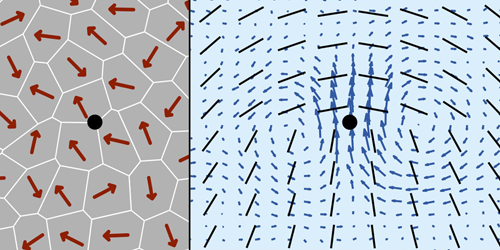Extending and Contracting Cells
Stretch an individual epithelial cell on a surface, and upon release, it will tend to contract back to its original shape. But some experiments have observed a fundamentally different behavior when such cells form tissues, which sometimes seem to prefer to extend—not contract—after stretching. Now, Andrew Killeen of Imperial College London and colleagues demonstrate with a model how this apparent change in behavior arises [1]. Their findings mean that some interpretations of past experiments may need to be updated, the researchers say.
Epithelial cells come in a variety of different shapes. Some epithelial tissues consist of elongated cells that tend to align like the rod-like molecules in a liquid crystal. However, such tissues contain sites where cells with one alignment butt against cells with another alignment. Previously, researchers studying these topological defects observed “extensile nematic behavior”: the cells moved as if they had a tendency to extend when stretched rather than to contract as individual cells on a substrate do.
To investigate how this apparent change in behavior arises, Killeen and colleagues hydrodynamically modeled a layer of cells on a surface, accounting specifically for cell-substrate interactions, such as the way cells propel themselves on a surface and the shear forces that act on cells when stretched. They found that fluctuations in cell-substrate forces could cause the defect regions to show extensile behavior even if the individual cells remained contractile; the cells only appeared to adopt extensile behavior within the cell layer. This finding means that researchers studying tissues on substrates may need to take cell-substrate interactions into account to get a complete picture of what is going on.
–Erika K. Carlson
Erika K. Carlson is a Corresponding Editor for Physics based in New York City.
References
- A. Killeen et al., “Polar fluctuations lead to extensile nematic behavior in confluent tissues,” Phys. Rev. Lett. 128, 078001 (2022).




